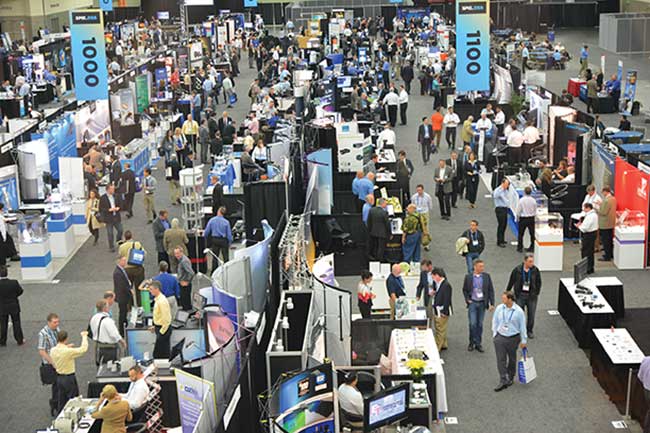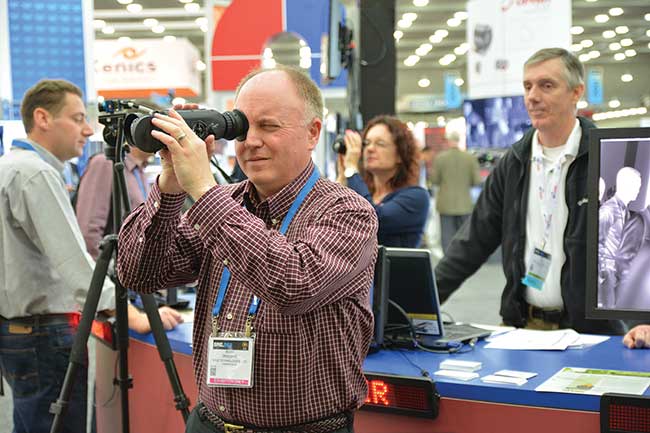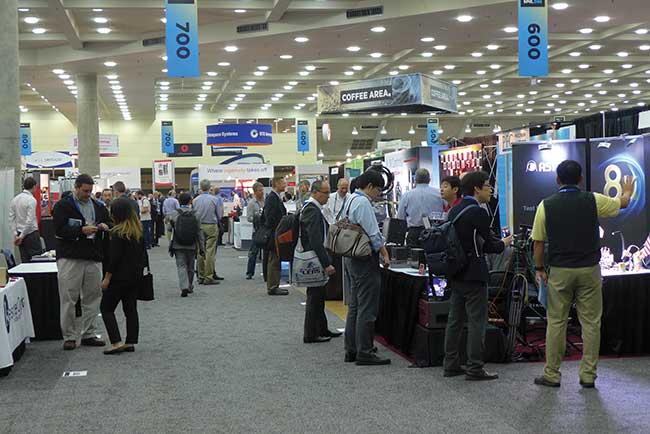The advancement of sensing and imaging technologies is evolving the defense and security sectors worldwide, with a wide variety of applications in such areas as machine vision, process control and counter-terrorism (among others). SPIE’s 2016 Defense + Commercial Sensing conference reflects this evolution, as well as enhanced content and expanded markets.
To be held April 17-21 at the Baltimore Convention Center in Maryland, this show is touted as “the leading global sensing and imaging event for defense and commercial applications.” It comprises two co-located sessions — Defense + Security, and Commercial + Scientific Sensing and Imaging. More than 2,000 technical presentations will be held during the week, in addition to 35 professional development courses, a comprehensive industry program, seminars and a major exhibition of suppliers of IR cameras, sensors, imaging systems, and other photonics technologies and products.

Thousands of people each year attend the annual global sensing and imaging event that focuses on the defense and commercial sensing sector.
“Over its … lifetime, SPIE Defense and Commercial Sensing has become the community’s leading event on optics and photonics technology, with core topics including infrared cameras, lasers, spectroscopy, 3D imaging, terahertz, and multi- and hyperspectral imaging,” said SPIE Senior Director Andrew Brown.
Speaking to this sector, as well as the market, and technologies and research sectors, will be Bradford C. Tousley — director of the Tactical Technology Office (TTO) at the U.S. Department of Defense’s Defense Advanced Research Projects Agency (DARPA) — and Patrick Carrick — director of the U.S. Department of Homeland Security (DHS) Homeland Security Advanced Research Project Agency (HSARPA) — in two separate plenary presentations.
The TTO taskforce serves to transform “the future of warfighting by pursuing high-risk, high-payoff tactical technology and development of rapid, mobile and responsive combat capability for advanced weapons, platforms and space systems.” Tousley’s work at TTO comes after his service as director of the technology division of Logos Technologies, headquartered in Virginia. There, he dealt with technology and business development in areas such as unmanned airborne persistent surveillance technology, hyperspectral imaging science, space situational awareness and sensors, UAV collision avoidance, software development, and advanced image processing algorithms.

An attendee checks out new equipment at the 2015 show.
Under HSARPA — an agency that “supports cutting-edge research to produce revolutionary changes in technologies, new capabilities, and threat and risk assessments for the Homeland Security Enterprise (HSE)” — Carrick works specifically with technology research and development for DHS. He also serves as HSARPA principal adviser for oversight and technical content of the research and development portfolio. Prior to this, Carrick was acting director of the U.S. Air Force Office of Scientific Research, and director of its Basic Science Program. He is also former director of the Shared Laser Facility at the University of Oregon.
Defense + Security
One of the largest meetings for defense technology (optics, lasers, imaging), Defense + Security caters to the world’s scientists, researchers and engineers from military, industry, academia and government agencies. This symposium is also noted as “a prime event” for government acquisition, policy and program executive representatives.
Numerous educational sessions will be held, focusing on:
• IR Sensors and Systems
• Defense, Homeland Security and Law Enforcement
• Intelligence, Surveillance and Reconnaissance
• Laser Sensors and Systems
• Next-Generation Sensors and Systems
• Displays
• Sensor Data and Information Exploitation
• Imagery and Pattern Analysis
• Information Systems and Networks: Processing, Fusion and Knowledge Generation
The best paper and best student paper awards for this symposium will be announced, as well. Topics are Signal Processing, Sensor/Information Fusion and Target Recognition; Algorithms for Synthetic Aperture Radar Imagery; Automatic Target Recognition; Infrared Technology and Applications; Chemical, Biological, Radiological, Nuclear and Explosives Sensing; and Micro- and Nanotechnology Sensors, Systems and Applications.

DCS provides a look at the latest technologies and potential applications.
Commercial + Scientific Sensing and Imaging
The Commercial + Scientific Sensing and Imaging symposium is focused on commercial and industrial sensing technologies and applications. The photonics-based sensors realm is expanding, providing a rich environment for the development and deployment of new technologies. The potential for leveraging real-time data that is produced from a global network of distributed sensors (in smart devices) opens up a world of new opportunities, according to SPIE.
Commercial + Scientific Sensing and Imaging offers a look at the latest technologies and their applications in areas such as health care, industrial processing, manufacturing, communications and transportation.
This symposium offers several educational sessions, too. Among them,
• Imaging and Sensing Technologies
• Sensing for Industry, Environment and Health
• Imaging and Data Visualization
• Information Systems and Networks: Processing, Fusion and Knowledge Generation
Awards for best paper and best student paper will be handed out as part of this symposium. Topics include Image Sensing Technologies: Materials, Devices, Systems and Applications; Advanced Photon Counting Techniques; Thermosense: Thermal Infrared Applications; Smart Biomedical and Physiological Sensor Technology; Sensing for Agriculture and Food Quality and Safety; Energy Harvesting and Storage: Materials, Devices and Applications; Three-Dimensional Imaging, Visualization and Display; and Autonomous Air and Ground Sensing Systems for Agricultural Optimization and Phenotyping.
Professional development, industry events
Training and development courses bring focused instruction from some of the biggest names in industry and research. There will be 35 courses offered in numerous technology tracks, as well as applications and approaches for lasers, sensors, imaging, IR systems, optics, and optomechanical engineering, among others.
A job fair will provide a forum for job seekers and some of the world’s top industry employers; recruiters from BAE Systems, DHPC Technologies, IPG Photonics, L3, General Dynamics, II-VI and others will be available on the exhibit floor.
SPIE DCS also provides the opportunity to develop connections and potentially spark collaboration within the business market. Veteran executives, technology thought-leaders and entrepreneurs will lead programs throughout the week. Among them, a vendor lecture titled Infrared Applications: ThermoSense. This will feature brief presentations from hardware and software vendors whose product lines impact thermal imaging applications. All DCS exhibitors are eligible to present their products during this event.
Other presentations will include Emerging Markets: Autonomous Vehicles Drive Miniaturization of Solid-State Lidar and MMW Radar Solutions (sponsored by Imec), and there will be a special presentation by FLIR. William Chappell, director of DARPA’s Microsystems Technology Office (MTO), will deliver the keynote presentation — Information Extraction at the Sensor. The future of sensor applications in areas like agriculture, pharmaceuticals and more will also be discussed in a session moderated by Joseph X. Montemarano of Princeton University; panelists are Douglas E. Kiehl of Eli Lilly, and Ralph Taylor-Smith of Battelle Ventures and Innovation Valley Partners.
Exhibition
Nearly 400 of the world’s top companies will show off their products. Two technology demonstrations are scheduled: A thermal imaging demonstration, presented by DRS Technologies, will showcase the versatility of long-wave infrared technology and its detection capabilities. This will be a hands-on demonstration of some of the world’s most advanced thermal imaging products. And a demonstration by IJK Controls will show how the “unlimited field of regard-stabilized gimbal” is changing the way movies are made. Visitors will be able to interact with the technology, which is enabling new types of cinematography.
Other featured technologies during the exhibition include infrared sources, detectors and systems; chemical and biological sensing; lasers and other light sources, laser accessories and laser systems; cameras and CCD components; displays; imaging components, equipment and systems; fiber optic components, equipment and systems; optical components including specialized lenses and coatings; high-speed imaging and sensing; high-precision optics manufacturing; robotics; law enforcement technology; photonic sensors, spectroscopy, multispectral and hyperspectral; fiber sensors; and lidar.
“Development of … technologies for defense and security applications stimulates a vital flow of new capabilities for scientific research and new commercial applications [in] oil and gas exploration, health care, wearable sensors, the Internet of Things, autonomous vehicles, [and] drones employed as mobile sensing platforms, to name a few,” said SPIE’s Brown.
He noted that markets are as wide-ranging as homeland defense, food safety, terrorism countermeasures, machine vision, robotic vision and imaging, precision agriculture and standoff detection.
To learn more about SPIE DCS 2016, visit spie.org.
SPIE Defense + Commercial Sensing 2016 Exhibitors
Exhibitors at DCS hail from all over the world, showing off their most innovative work and products. Among those that will be in attendance in 2016:
Alluxa
Santa Rosa, Calif.
+1 855-425-5892; www.alluxa.com
Booth 233
Corning Advanced Optics
Corning, N.Y.
+1 607-974-9000; www.corning.com
Booth 448
Edmund Optics Inc.
Barrington, N.J.
+1 856-547-3488; www.edmundoptics.com
Booth 637
Epix Inc.
Buffalo Grove, Ill.
+1 847-465-1818; www.epixinc.com
Booth 334
Fisba AG
St. Gallen, Switzerland
+41 71-282-31-31; www.fisba.com
Booth 1117
FLIR Systems
Meer, Belgium
+32 3665-5100; www.flir.com
Booth 822
Hamamatsu Corp.
Bridgewater, N.J.
+1 908-231-0960; www.hamamatsu.com
Booth 316
InfraTec GmbH
Dresden, Germany
+49 351-871-8620; www.infratec.eu
Booth 314
ISP Optics Corp.
Irvington, N.Y.
+1 914-591-3070; www.ispoptics.com
Booth 1022
Kentek Corp.
Pittsfield, N.H.
+1 603-223-4900; www.kenteklaserstore.com
Booth 1036
LaCroix Optical Co.
Batesville, Ark.
+1 870-698-1881; www.lacroixoptical.com
Booth 643
Laser Components USA Inc.
Bedford, N.H.
+1 603-821-7040;
www.lasercomponents.com/us
Booth 542
Meller Optics Inc.
Providence, R.I.
+1 401-331-3717; www.melleroptics.com
Booth 531
Nufern
East Granby, Conn.
+1 860-408-5000; www.nufern.com
Booth 1017
Optikos Corp.
Wakefield, Mass.
+1 617-354-7557; www.optikos.com
Booth 723
Siskiyou Corp.
Grants Pass, Ore.
+1 541-479-8697; www.siskiyou.com
Booth 733
Teledyne DALSA
Waterloo, Ontario, Canada
+1 519-886-6000; www.teledynedalsa.com
Booth 717
Trioptics GmbH
Wedel, Germany
+49 4103-18006-0; www.trioptics.com
Booth 543